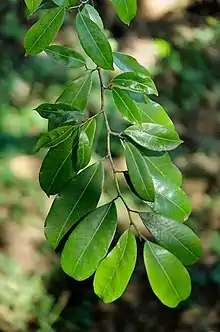Trilepisium
Trilepisium, the urnfigs or false-figs, is a small Afrotropical genus of plants in family Moraceae. They grow to medium-sized or large trees that occur in evergreen and semi-deciduous forests, flooded forests or forest patches and often along rivers and streams,[1] and at altitudes of up to 2,000 m[2] and over.[3]
| Urnfigs | |
|---|---|
 | |
| T. madagascariense | |
| Scientific classification | |
| Kingdom: | Plantae |
| Clade: | Tracheophytes |
| Clade: | Angiosperms |
| Clade: | Eudicots |
| Clade: | Rosids |
| Order: | Rosales |
| Family: | Moraceae |
| Tribe: | Dorstenieae |
| Genus: | Trilepisium Du Petit-Thouars, 1806 |
Description
The bole may be 60 cm wide, and is often fluted at the base.[3] The smooth, grey bark is very lenticellate[4] and exudes a cream-coloured latex when damaged.[2] The yellowish to pinkish slash turns purple-red as it dries.[4] They usually branch high up to form a small and loosely pyramidal crown[3] with drooping twigs. Stipules of terminal buds eventually leave annular scars.[4]
The glossy and very dark elliptic leaves have a prominent driptip,[1] and measure up to 14 cm long.[2] They are glossy below, and have two small lobes at the base.[4]
The flowers appear in spring and are arranged in a whitish to mauve puff.[2] The puff is about 1 cm in diameter,[1] and consists of staminate male flowers and pistillate female flowers, without perianths,[2] which obscure the view of the receptacle.[5] The flowers protrude from the open apex of an urn-shaped receptacle which is about 1.5 cm long.[1]
The fig-like fruit, embedded in the fleshy receptacles, are some 2 cm long.[2] They are ellipsoidal in shape and hold a nutlet each.[1][4] Ripe fruit have the appearance of blue plums.[4]
Species
The two species are distinguished on floral characteristics:[6]
- Trilepisium gymnandrum (Baker) J.Gerlach – Silhouette Island, Seychelles
- Trilepisium madagascariense DC. – African mainland, Madagascar and Annobón island[3]
Uses and species associations
The wood of T. madagascariense is suitable for furniture, and the sap yields a red dye.[1] Its roasted seeds are eaten and it is sometimes cultivated.[3] A methanol extract, fractions and isoliquiritigenin from T. madagascariense stem bark has been shown to possess antidiarrheal activities,[7] and previously unknown trilepisflavan and trilepisuimic acid compounds were isolated from it in 2012.[8]
Trilepisium madagascariense is a larval foodplant for the butterfly Cyrestis camillus sublineata.[1] On the Seychelles the seeds are likely dispersed by frugivorous birds and fruit bats, but the pollinators are unknown.[6]
References
- Van Wyk, Braam; et al. (1997). Field Guide to Trees of Southern Africa. Cape Town: Struik. p. 82. ISBN 978-1-86825-922-9.
- Hyde, M.; et al. "Trilepisium madagascariense DC". Flora of Zimbabwe. Retrieved 19 November 2014.
- "Trilepisium madagascariense DC". Base de données des plantes d'Afrique. Conservatoire et Jardin botaniques & SANBI. 2012. Retrieved 19 November 2014.
- Jongkind, C.; et al. "Trilepisium madagascariense". Fauna and Flora of Liberia. Retrieved 19 November 2014.
- Robertson, Hamish. "Trilepisium madagascariense (Urn-fig)". Biodiversity explorer. Iziko Museums. Retrieved 19 November 2014.
- Gerlach, J. (2003). "Trilepisium gymnandrum". IUCN Red List of Threatened Species. 2003. Retrieved 19 November 2014.
- Kuiate, Jules-Roger; Kuete, Victor; Teponno, Remy Bertrand; Tapondjou, Leon Azefack; Vilarem, Gerard; Teke, Gerald Ngo (2010). "Antidiarrheal activity of extracts and compound from Trilepisium madagascariense stem bark". Indian Journal of Pharmacology. 42 (3): 157–63. doi:10.4103/0253-7613.66839. PMC 2937317. PMID 20871767.
- Ango, Patrick Y.; Kapche, Deccaux W.F.G.; Kuete, Victor; Ngadjui, Bonaventure T.; Bezabih, Merhatibeb; Abegaz, Berhanu M. (September 2012). "Chemical constituents of Trilepisium madagascariense (Moraceae) and their antimicrobial activity". Phytochemistry Letters. 5 (3): 524–528. doi:10.1016/j.phytol.2012.05.006.